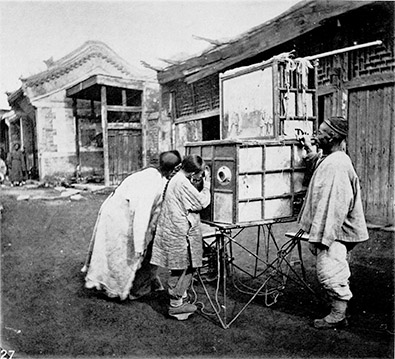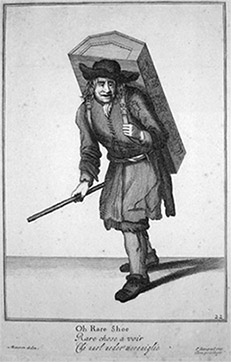The term Peep Show comes from Peeping Tom, the sneaky Coventry tailor who, disobeying the proclamation of the count, made a hole in the shutters to see Lady Godiva riding naked through the streets of the city; he was so impressed that he was struck blind.
The Peep Show, also known as a peep show box or raree (rarity show), can be traced back as early as the 15th century in Europe with Leon Battista Alberti. Another example, known as the perspective box, can be found in the 17th century so-called "Dutch Golden Age painting" where, through the manipulation of perspective, was created an illusion of three-dimensionality usually within a room.
But the most well-known form of Peep Show, born from the need to satisfy their tastes with the sense of sight, was mobile.
The spectator, through one or more spyholes, could look into a wooden box, inside which followed each of the images that were driven by the travellers.
 The interior of the boxes, to simulate the theatrical scenes, was richly decorated. While the images passed before the viewer's eyes, some actors recited to the rest of the curious public what was happening in the mysterious box.
The interior of the boxes, to simulate the theatrical scenes, was richly decorated. While the images passed before the viewer's eyes, some actors recited to the rest of the curious public what was happening in the mysterious box.
The Chinese Peep Show, which caught on in the 19th century, was known as yang P'ien ("pulling foreign picture cards"). In respect to the classic Peep Show, it foresaw that the general public was entertained with puppet shows or images of the strange, the exotic and the out-of-the-ordinary.
 In Ottoman Syria there existed a form of Peep Show called Sanduk al-ajayib ( "wonder box") that the walking was carrying on his back. In this case, on the box were six holes through which viewers could observe backlit scenes illuminated by a central candle.
In Ottoman Syria there existed a form of Peep Show called Sanduk al-ajayib ( "wonder box") that the walking was carrying on his back. In this case, on the box were six holes through which viewers could observe backlit scenes illuminated by a central candle.
These boxes generally showed contemporary stories or scenes of paradise and the invalid.
Other common subjects of Peep Show worldwide, presented animals, far-off landscapes, classical theater scenes, masks, ceremonies or court festivals, figures in transformation such as from anges to devils, and-of course- pictures of indecent scenes.


In 1894 the first machines that reproduced slides of naked women's movement were built. A few years later, during the early years of '900, even Thomas Alva Edison, the inventor of the light bulb, made some movies depicting erotic situations in common contexts.


Subsequently, starting from this idea, in 1972 in New York the first live Peep Shows opened. Unlike the classic striptease, the viewer could see women in dishabille through windows. Though less common, the Peep Show still came to be used inside certain establishments. The female performer, placed in the center of a circular stage around which were arranged the private cabins, strips and often has sexual relations with another artist. The viewer enters the money in the machine and the window is opened for a predetermined time. The time of a dream.
Il termine Peep Show deriva da Peeping Tom, un sarto spione di Coventry. L’uomo, disobbedendo al proclama del Conte, fece un foro nella persiana per vedere Lady Godiva cavalcare nuda lungo le strade della città, e rimase talmente impressionato da divenire cieco.
Il Peep Show, noto anche come scatola peep o raree show (rarity show), si può far risalire già a partire dal 15° secolo in Europa con Leon Battista Alberti. Un altro esempio, conosciuto come la scatola prospettiva, lo troviamo nel 17° secolo durante il cosiddetto “Dutch Golden Age painting” dove, attraverso la manipolazione della prospettiva, veniva creata un’illusione di tridimensionalità solitamente all’interno di una stanza.
Ma la forma più conosciuta del Peep Show, nata dall’esigenza di soddisfare il proprio piacere con il senso della vista, era itinerante. Lo spettatore, attraverso uno o più fori, poteva guardare in una scatola di legno dentro cui si susseguivano delle immagini che venivano azionate dall’ambulante.
 L’interno delle scatole, per simulare le scene teatrali, era riccamente decorato. Mentre le immagini passavano davanti agli occhi dello spettatore, alcuni attori recitavano al resto del pubblico quello che stava accadendo nella misteriosa scatola.
L’interno delle scatole, per simulare le scene teatrali, era riccamente decorato. Mentre le immagini passavano davanti agli occhi dello spettatore, alcuni attori recitavano al resto del pubblico quello che stava accadendo nella misteriosa scatola.
Anche il Peep Show Cinese, ha preso piede a partire dal 19° secolo. Conosciuto come yang p'ien ("pulling foreign picture cards") rispetto al classico Peep Show prevedeva che il pubblico esterno venisse intrattenuto con spettacoli di burattini o con immagini strane e fuori dagli schemi.
 Nella Syria Ottomana esisteva una forma di Peep Show che si chiamava sanduk al-ajayib ("wonder box") che l’ambulante si portava sulla schiena. In questo caso, sulla scatola erano presenti sei buchi attraverso i quali gli spettatori potevano osservare scene in controluce illuminate da una candela centrale.
Nella Syria Ottomana esisteva una forma di Peep Show che si chiamava sanduk al-ajayib ("wonder box") che l’ambulante si portava sulla schiena. In questo caso, sulla scatola erano presenti sei buchi attraverso i quali gli spettatori potevano osservare scene in controluce illuminate da una candela centrale.
Queste scatole mostravano generalmente storie contemporanee o scene del paradiso e dell’infermo.
Altri soggetti comuni del Peep Show in tutto il mondo, rappresentavano animali, paesaggi esotici, scene di teatro classico, maschere, cerimonie o feste di corte, figure in trasformazione (es. da angelo a diavolo) e, naturalmente, immagini e scenette indecenti.


Nel 1894 furono costruite le prime macchine che riproducevano diapositive in movimento di donne nude. Pochi anni dopo, durante i primi anni del ‘900, anche Thomas Alva Edison, l’inventore della lampadina, realizzò alcuni filmati che ritraevano situazioni erotiche in contesti comuni.


Successivamente, partendo da questa idea, nel 1972 a New York fu aperto il primo Peep Shows live. A differenza del classico spogliarello, lo spettatore poteva vedere donne in deshabillé attraverso una finestrella.Anche se è meno diffuso, il Peep Show viene ancora utilizzato all’interno di alcuni locali. L’interprete femminile, posizionata al centro di un palco circolare attorno al quale sono disposte le cabine private, si spoglia e spesso intrattiene rapporti sessuali con un altro artista. Lo spettatore inserisce i soldi nel macchinario e la finestrella si apre per un tempo prestabilito.
Il tempo di un sogno.
